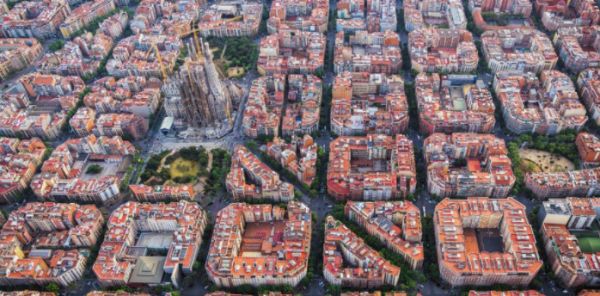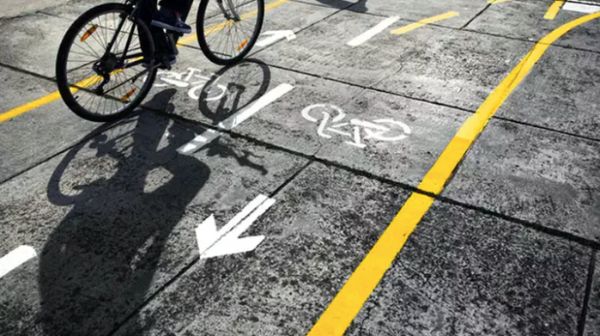Sustainable Cities After Covid-19: Are Barcelona-style Green Zones The Answer?
The lockdowns and restrictions introduced to control the spread of Covid-19 have resulted in huge changes to urban life.

Previously bustling city centres remain empty, shunned in favour of suburban or rural areas where social distancing is easier and connections to the outdoors are abundant.
The roll out of vaccines provides hope for a partial restoration of normality in cities. However, the impact of Covid-19 could last much longer.
In particular, the pandemic has shown how damaging congestion, pollution and lack of green space can be—including how these factors have contributed to the severity of suffering for city dwellers. We have an opportunity to change city living for the better.
Barcelona offers an example of how city areas can be transformed to reduce pollution and increase access to green space.
The city pioneered the concept of superblocks, first introduced in 2016, as part of green urban planning. Superblocks are neighbourhoods of nine blocks.
Traffic is restricted to major roads around the superblocks, leaving the streets inside for pedestrians and cyclists.
Recently, further plans have been announced to expand green zones in the city’s central district, Eixample.
This is a major expansion of low-traffic zones, giving priority to pedestrians and cyclists to reduce pollution and provide green spaces.
The new plan will cover 21 streets and have space for 21 new pedestrian plazas at intersections.
At least 80 per cent of each street is to be shaded by trees in summer and 20 per cent unpaved. A public competition in May 2021 will decide the final design.
The purpose of the plan is to ensure that no resident will be more than 200 metres from a green space.
There are many benefits to creating urban green spaces like these. They include an improvement in air quality and noise levels on the car-free streets, and a reduction in levels of nitrogen dioxide (NO) from road traffic.
Exposure to high level of NO can lead to a range of respiratory problems.
Green spaces have been shown to improve mental health, as well as lead to a reduction in risk of obesity and diabetes—conditions which significantly increase vulnerability to Covid-19.
Covid-19 has made the case for green urban planning even more compelling. However, these plans can come at a cost.
Barriers to green cities
A particular negative impact of green zones could be a high demand for housing, leading to subsequent rises in property prices.
This can lead to gentrification and displacement of local residents and businesses.
Care must be taken to make sure that homes remain affordable and urban green zones do not become rich enclaves.
The Covid-19 lockdowns highlighted the difference in living conditions faced by city dwellers.
Green initiatives must work for all socio-economic groups, and must not exacerbate existing inequalities.
In addition, while city centres are the usual focus areas for greening initiatives, suburbs and other peripheral areas also need attention.
The goal is to reduce carbon dependence in total—not shift it from one area to another, or one sector to another.
The plan should also include steps to make private and public transport completely green.
This could include replacing carbon-producing transport system with zero-emission vehicles and providing ample infrastructure such as dedicated lanes and charging stations for electric vehicles.
Cities differ hugely in how they look, shape and operate. One size will not fit all. If other cities choose to follow Barcelona’s model, local issues must be carefully considered.
Superblocks work really well in a neat grid system such as in central Barcelona. But many cities do not have a well-designed grid system.

However, the principles of green, environmentally friendly, car-free or restricted-traffic neighbourhoods can be adopted in any city.
Examples of schemes include low-traffic neighbourhoods in London, the 15-minute city initiative in Paris, or Manchester’s plans for a zero-carbon city centre.
While adopting such interventions, it is important to keep citizens’ daily needs in mind to avoid adding extra burdens on them.
If motor traffic is to be limited, the availability of public transport must be considered, safe infrastructure for walking and cycling as well as adequate road structure for essential services or deliveries.
Significant capital investment is needed to support these plans. The Barcelona plan is projected to cost €38 million (AUD$60 million).
Much more will be required if it is to roll out to more areas. Cities in the developing world and poorer countries cannot afford such huge sums.
Moreover, Covid-19 has left several cities laden with a huge amount of debt.
Green city initiatives need to be long-term—and created with the support of local people.
Recognition of the benefits of green living and informed support of developments will result in positive behaviour changes by the citizens.
The Conversation


 UNICEF: Statement By UNICEF Executive Director On The Children Killed By The Alarming Escalation Of Violence In The Middle East
UNICEF: Statement By UNICEF Executive Director On The Children Killed By The Alarming Escalation Of Violence In The Middle East Big Shift Global Campaign: The World Bank Is Making Bad Economic Decisions | U-Turning On Its Energy Policies
Big Shift Global Campaign: The World Bank Is Making Bad Economic Decisions | U-Turning On Its Energy Policies UN Department of Global Communications: FAO Releases The Most Detailed Global Assessment Of Marine Fish Stocks To Date
UN Department of Global Communications: FAO Releases The Most Detailed Global Assessment Of Marine Fish Stocks To Date World Economic Forum: Gender Gap Closes At Fastest Rate Since Pandemic
World Economic Forum: Gender Gap Closes At Fastest Rate Since Pandemic KidsRights: KidsRights Index 2025 Now Available
KidsRights: KidsRights Index 2025 Now Available CNS: We Can Do Better So That All People With HIV Live Healthy Normal Lifespans
CNS: We Can Do Better So That All People With HIV Live Healthy Normal Lifespans